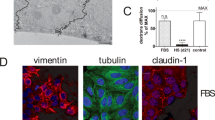Summary
A clonal strain of rat hepatoma cells (MH1C1) has been established from Morris hepatoma 7795. The cells grow slowly and have been serially propagated in culture without evidence of senescence for over 2 years. They perform the following differentiated functions in vitro:
-
1.
MH1C1 cells produce serum albumin and secrete it into the culture medium. The rate of production of albumin is stimulated 3- to 12-fold by adding hydrocortisone to the medium.
-
2.
The ninth component of complement (C9) is synthesized by MH1C1 cells, a finding which gives evidence that this trace complement component may be a liver product. The synthesis of C9 is not stimulated by hydrocortisone.
-
3.
Testosterone is metabolized by the MH1C1 cells by pathways which are very similar to, or the same as, those found in normal liver. Evidence for the following testosterone metabolizing enzymes has been obtained: 17β-hydroxysteroid dehydrogenase, Δ4-3-ketosteroid 5α-reductase, 6β-, 7α-, and 16β-hydroxylases, urindine diphosphate glucuronyl transferase, and 17β-hydroxysteroid sulfotransferase.
-
4.
MH1C1 cells produce tyrosine aminotransferase and respond to hydrocortisone by rapidly increasing the activity of this enzyme.
Multiple differentiated functions which are responsive to exogenous signals lead us to conclude that the MH1C1 cells are a useful model for studying the integration of control mechanisms within a single type of cell.
Similar content being viewed by others
References
Sato, G. H., and Y. Yasumura. 1966. Retention of differentiated function in dispersed cell culture. Trans. N. Y. Acad. Sci. 28: 1063–1079.
Yasumura, Y., A. H. Tashjian, Jr., and G. H. Sato. 1966. Establishment of four functional, clonal strains of animal cells in culture. Science 154: 1186–1189.
Yasumura, Y. 1968. Retention of differentiated function in clonal animal cell lines, particularly hormone-secreting cultures. Amer. Zoologist 8: 285–305.
Tashjian, A. H., Jr., Y. Yasumura, L. Levine, G. H. Sato, and M. L. Parker. 1968. Establishment of clonal strains of rat poituitary tumor cells that secrete growth hormone. Endocrinology 82: 342–352.
Shin, S.-I. 1967. Studies on interstitial cells in tissue culture: steroid biosynthesis in monolayers of mouse testicular interstitial cells. Endocrinology 81: 440–448.
Kowal, J., and F. Fiedler 1968. Adrenal cells in tissue culture. I. Assay of steroid products; steroidogenic responses to peptide hormones. Arch. Biochem. Biophys. 128: 406–421.
Benda, P., J. Lightbody, G. Sato, L. Levine, and W. Sweet, 1968. Differentiated rat glial cell strain in tissue culture. Science 161: 370–371.
Pierson, R. W. 1967. Metabolism of steroid hormones in adrenal cortex tumor cultures. Endocrinology 81: 693–707.
Bancroft, F. C., L. Levine, and A. H. Tashjian Jr. 1969. Control of growth hormone production by a clonal strain of rat pituitary cells: stimulation by hydrocortisone. J. Cell Biol. 43: 432–441.
Richardson, U. I., A. H. Tashjian, Jr., and L. Levinc. 1969. Establishment of a clonal strain of hepatoma cells which secrete albumin. J. Cell Biol. 40: 236–247.
Ham, R. G. 1963. An improved nutrient solution for diploid Chinese hamster and human cell lines. Exp. Cell Res. 29: 515–526.
Lowry, O. H., N. F. Rosebrough, A. L. Farr, and R. J. Randall 1951. Protein measurement with the Folin phenol reagent. J. Biol. Chem. 193: 265–275.
Rommel, F. A., and R. Stolfi 1968. Preparation and partial characterization of sheep erythrocyte-antibody-complement intermediate EAC. Immunology 15: 469–479.
Baulieu, E. E., and P. Mauvais-Jarvis. 1964. Studies on testosterone metabolism. I. Conversion of testosterone-17α-3H to 5α- and 5β-andostane-3α, 17β-diol-17α-3H: a new “17β-hydroxyl pathway”. J. Biol. Chem. 239: 1569–1577.
Diamondstone, T. I. 1966. Assay of tyrosine transaminase activity by conversion ofp-hydroxyphenylpyruvate top-hydroxybenzaldehyde. Anal. Biochem. 16: 395–401.
Nowell, P. C., H. P. Morris, and V. R. Potter. 1967. Chromosomes of “minimal deviation” hepatomas and some other transplantable rat tumors. Cancer Res. 27: 1565–1579.
Wettstein, F. O., H. Noll, and S. Penman. 1964. Effect of cycloheximide on ribosomal aggregates engaged in protein synthesisin vitro. Biochim. Biophys. Acta 87: 525–528.
Nathans, D. 1964. Puromycin inhibition of protein synthesis: incorporation of puromycin into peptide chains. Proc. Nat. Acad. Sci. U. S. A. 51: 585–592.
Nishioka, K., and W. D. Linscott. 1963. Components of guinea pig complement. II. Separation of serum fractions essential for immune hemolysis. J. Exp. Med. 118: 795–815.
Muller-Eberhard, H. J. 1968. Chemistry and reaction mechanisms of complement. In: F. J. Dixon and H. G. Kunkel (Eds.), Advances in Immunology. Volume 8. Academic Press, New York, p. 1.
Rother, K. O., U. A., Rother, M. E. Phillips, O. Goetze, and J. G. Thorbecke. 1968. Further studies on sites of production of C′ components. Abstracts of Complement Workshop. J. Immunol. 101: 814.
Tomkins, G. M., E. B. Thompson, S. Hayashi, T. Gelehrter, D. Granner, and B. Peterkofsky. 1966. Tyrosine transaminase induction in mammalian cells in tissue culture. Cold Spring Harbor Symp. Quant. Biol. 31: 349–360.
Author information
Authors and Affiliations
Additional information
Supported in part by research grants from the United States Public Health Service (AM-11011) and the American Cancer Society, Inc. (E-222 and P-374), and by an appropriation by the Commonwealth of Massachusetts (Item 2026-50-02).
Research Career Development Awardee, National Institute of Arthritis and Metabolic Diseases (AM-13,561).
Postdoctoral Research Fellow, National Institute of General Medical Sciences (GM-21,175).
Postdoctoral Research Fellow, United States Public Health Service Training Grant (5T01-AI-00282-05).
Rights and permissions
About this article
Cite this article
Tashjian, A.H., Bancroft, F.C., Richardson, U.I. et al. Multiple differentiated functions in an unusual clonal strain of hepatoma cells. In Vitro 6, 32–45 (1970). https://doi.org/10.1007/BF02616132
Issue Date:
DOI: https://doi.org/10.1007/BF02616132




